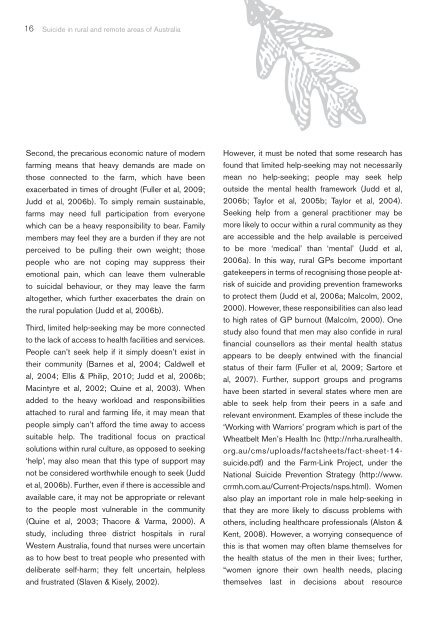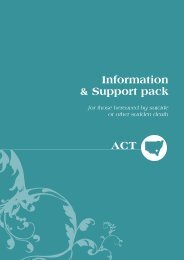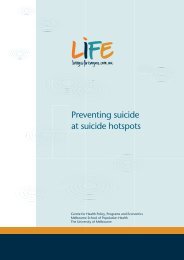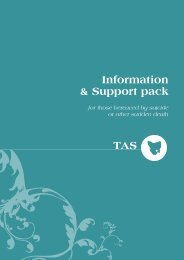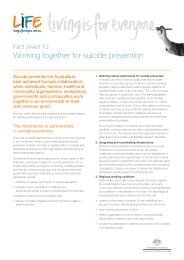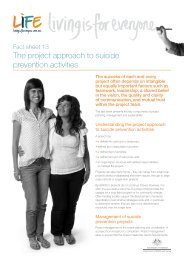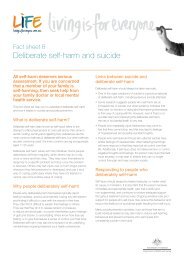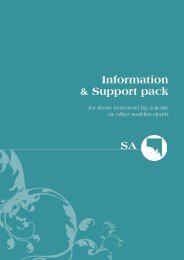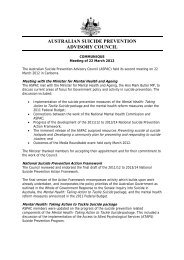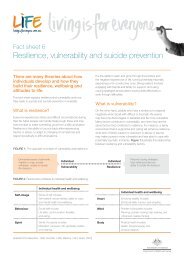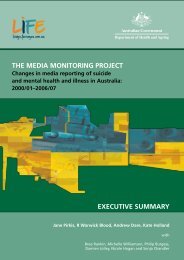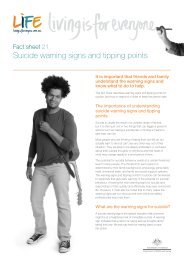SUICIDE in RURAL & REMOTE AREAS of AUSTRALIA - Living is for ...
SUICIDE in RURAL & REMOTE AREAS of AUSTRALIA - Living is for ...
SUICIDE in RURAL & REMOTE AREAS of AUSTRALIA - Living is for ...
Create successful ePaper yourself
Turn your PDF publications into a flip-book with our unique Google optimized e-Paper software.
16<br />
Suicide <strong>in</strong> rural and remote areas <strong>of</strong> Australia<br />
Second, the precarious economic nature <strong>of</strong> modern<br />
farm<strong>in</strong>g means that heavy demands are made on<br />
those connected to the farm, which have been<br />
exacerbated <strong>in</strong> times <strong>of</strong> drought (Fuller et al, 2009;<br />
Judd et al, 2006b). To simply rema<strong>in</strong> susta<strong>in</strong>able,<br />
farms may need full participation from everyone<br />
which can be a heavy responsibility to bear. Family<br />
members may feel they are a burden if they are not<br />
perceived to be pull<strong>in</strong>g their own weight; those<br />
people who are not cop<strong>in</strong>g may suppress their<br />
emotional pa<strong>in</strong>, which can leave them vulnerable<br />
to suicidal behaviour, or they may leave the farm<br />
altogether, which further exacerbates the dra<strong>in</strong> on<br />
the rural population (Judd et al, 2006b).<br />
Third, limited help-seek<strong>in</strong>g may be more connected<br />
to the lack <strong>of</strong> access to health facilities and services.<br />
People can’t seek help if it simply doesn’t ex<strong>is</strong>t <strong>in</strong><br />
their community (Barnes et al, 2004; Caldwell et<br />
al, 2004; Ell<strong>is</strong> & Philip, 2010; Judd et al, 2006b;<br />
Mac<strong>in</strong>tyre et al, 2002; Qu<strong>in</strong>e et al, 2003). When<br />
added to the heavy workload and responsibilities<br />
attached to rural and farm<strong>in</strong>g life, it may mean that<br />
people simply can’t af<strong>for</strong>d the time away to access<br />
suitable help. The traditional focus on practical<br />
solutions with<strong>in</strong> rural culture, as opposed to seek<strong>in</strong>g<br />
‘help’, may also mean that th<strong>is</strong> type <strong>of</strong> support may<br />
not be considered worthwhile enough to seek (Judd<br />
et al, 2006b). Further, even if there <strong>is</strong> accessible and<br />
available care, it may not be appropriate or relevant<br />
to the people most vulnerable <strong>in</strong> the community<br />
(Qu<strong>in</strong>e et al, 2003; Thacore & Varma, 2000). A<br />
study, <strong>in</strong>clud<strong>in</strong>g three d<strong>is</strong>trict hospitals <strong>in</strong> rural<br />
Western Australia, found that nurses were uncerta<strong>in</strong><br />
as to how best to treat people who presented with<br />
deliberate self-harm; they felt uncerta<strong>in</strong>, helpless<br />
and frustrated (Slaven & K<strong>is</strong>ely, 2002).<br />
However, it must be noted that some research has<br />
found that limited help-seek<strong>in</strong>g may not necessarily<br />
mean no help-seek<strong>in</strong>g; people may seek help<br />
outside the mental health framework (Judd et al,<br />
2006b; Taylor et al, 2005b; Taylor et al, 2004).<br />
Seek<strong>in</strong>g help from a general practitioner may be<br />
more likely to occur with<strong>in</strong> a rural community as they<br />
are accessible and the help available <strong>is</strong> perceived<br />
to be more ‘medical’ than ‘mental’ (Judd et al,<br />
2006a). In th<strong>is</strong> way, rural GPs become important<br />
gatekeepers <strong>in</strong> terms <strong>of</strong> recogn<strong>is</strong><strong>in</strong>g those people atr<strong>is</strong>k<br />
<strong>of</strong> suicide and provid<strong>in</strong>g prevention frameworks<br />
to protect them (Judd et al, 2006a; Malcolm, 2002,<br />
2000). However, these responsibilities can also lead<br />
to high rates <strong>of</strong> GP burnout (Malcolm, 2000). One<br />
study also found that men may also confi de <strong>in</strong> rural<br />
fi nancial counsellors as their mental health status<br />
appears to be deeply entw<strong>in</strong>ed with the fi nancial<br />
status <strong>of</strong> their farm (Fuller et al, 2009; Sartore et<br />
al, 2007). Further, support groups and programs<br />
have been started <strong>in</strong> several states where men are<br />
able to seek help from their peers <strong>in</strong> a safe and<br />
relevant environment. Examples <strong>of</strong> these <strong>in</strong>clude the<br />
‘Work<strong>in</strong>g with Warriors’ program which <strong>is</strong> part <strong>of</strong> the<br />
Wheatbelt Men’s Health Inc (http://nrha.ruralhealth.<br />
org.au/cms/uploads/factsheets/fact-sheet-14-<br />
suicide.pdf) and the Farm-L<strong>in</strong>k Project, under the<br />
National Suicide Prevention Strategy (http://www.<br />
crrmh.com.au/Current-Projects/nsps.html). Women<br />
also play an important role <strong>in</strong> male help-seek<strong>in</strong>g <strong>in</strong><br />
that they are more likely to d<strong>is</strong>cuss problems with<br />
others, <strong>in</strong>clud<strong>in</strong>g healthcare pr<strong>of</strong>essionals (Alston &<br />
Kent, 2008). However, a worry<strong>in</strong>g consequence <strong>of</strong><br />
th<strong>is</strong> <strong>is</strong> that women may <strong>of</strong>ten blame themselves <strong>for</strong><br />
the health status <strong>of</strong> the men <strong>in</strong> their lives; further,<br />
“women ignore their own health needs, plac<strong>in</strong>g<br />
themselves last <strong>in</strong> dec<strong>is</strong>ions about resource<br />
GriffithBook FINAL 20/09.<strong>in</strong>dd 16<br />
15/11/12 4:28 PM


